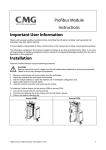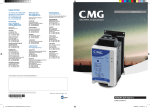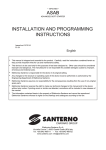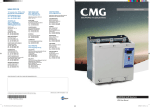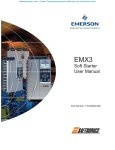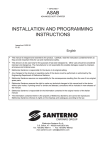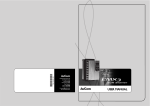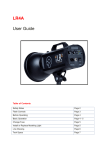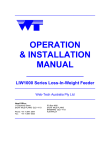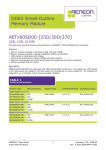Download Remote Operator User Manual
Transcript
Remote Operator Instructions Important User Information Observe all necessary safety precautions when controlling the soft starter remotely. Alert personnel that machinery may start without warning. It is the installer's responsibility to follow all instructions in this manual and to follow correct electrical practice. Use all internationally recognised standard practice for RS485 communications when installing and using this equipment. The information contained in this manual is subject to change at any time and without prior notice. In no event will responsibility or liability be accepted for direct, indirect or consequential damages resulting from the use or application of this equipment. General Description The Remote Operator allows remote operation of the soft starter, and offers the following functionality: • Operational control (Start, Stop, Reset, Quick Stop) • Starter status monitoring (Ready, Starting, Running, Stopping, Tripped) • Performance monitoring (motor current, motor temperature) • Trip code display • 4-20 mA Analog output (motor current) 1 • Optional RS485 network connection 1 The Remote Operator can act as a gateway device for connection to an RS485 serial communications network, allowing remote control of a motor using Modbus RTU or standard AP ASCII communications protocol. For further information, please refer to the Modbus Module Instructions. NOTE In order to use the Remote Operator with Aurora LPRB starters, a Remote Operator Module or Modbus Module must also be installed. NOTE In order to use the Remote Operator with Aurora LPRA starters, a Modbus Module must also be installed. Installation This section describes how to install the Remote Operator for basic control and monitoring of a soft starter. The Remote Operator is pre-configured to control a soft starter once control supply power is applied to both devices. For basic operation, no parameter adjustments are required on the Remote Operator or the soft starter. In order to use the Remote Operator's 4-20 mA analog output to monitor motor current, follow the instructions in the section 4-20 mA Analog Output on page 7. CMG Aurora | Remote Operator 1106 (edition 1.0.0) 1 Mounting 1 The Remote Operator is rated IP54 or NEMA 12 when mounted correctly in accordance with these instructions. It is intended for use on the flat surface of a panel, with all external wiring connected from behind the panel. The Remote Operator is supplied with a mounting bracket and four fasteners. The built-in gasket seal guarantees protection from outside the panel. Select the panel location of the Remote Operator. The required panel cutout is 92 mm x 92 mm. Place the Remote Operator through the cutout and locate the mounting bracket at the rear of the panel onto the four studs. Use the four fasteners to tighten the mounting bracket up to the rear of the panel. 1 For use on a flat surface of a NEMA 1 or NEMA 12 enclosure. Fasteners (x4) 1 2 3 Mounting bracket Universal panel cutout (92 mm x 92 mm) Remote Operator 4 Connection The Remote Operator requires a minimum of three electrical connections - the external power supply, the chassis earth and the RS485 Starter port. All external wiring, except the chassis earth (M4 stud provided), is 2 connected to spring operated clamp connector terminals with a maximum wire size of 2.5 mm . No special tools are required. Grounding and Shielding Twisted pair data cable with earth shield is recommended. The cable shield should be connected to the GND device terminal at both ends and one point of the site protective earth. Termination Resistors In long cable runs prone to excessive noise interference, termination resistors should be installed between the data lines at both ends of the RS485 cable. This resistance should match the cable impedance (typically 120 Ω). Do not use wire wound resistors. RS485 Data Cable Connection Daisy chain connection is recommended. This is achieved by parallel connections of the data cable at the actual device terminals. Remote Operator RS485 Network Connection Specifications Input impedance: Common mode voltage range: Input sensitivity: Minimum differential output voltage: 2 12 kΩ - 7 V to + 12 V ± 200 mV 1.5 V (with max loading of 54 Ω) CMG Aurora | Remote Operator 1106 (edition 1.0.0) For Use with Aurora LPRB 08477.A In order to use the Remote Operator with Aurora LPRB soft starters, a Remote Operator Module or Modbus Module must be installed to the starter. 1. Remove control power and mains supply from the soft starter. 2. Attach the module to the soft starter as illustrated. 3. Connect the Remote Operator to the module. Connection 1 3 4 + GND - 2 + GND - + - - GND + - GND + ~/+ ~/- Aurora LPRB Remote Operator Module – RS485 serial port B10, B11 - 4~20 mA analog output B1, B2, B3 - RS485 starter connection B6, B7, B8 - RS485 network connection 1, 2 - Supply voltage (18~30 VAC/VDC) RS485 Serial communication network connection (Modbus RTU or AP ASCII) For the Remote Operator to accept serial commands, a link must be fitted across terminals A1-02 on Aurora LPRB starters. CMG Aurora | Remote Operator 1106 (edition 1.0.0) 3 Configuration The Remote Operator Module does not require configuration. If the Aurora LPRB is connected to the Remote Operator via a Modbus Module, the module must be configured correctly. The DIP switches on the Modbus Module must be set as follows: ON 1 2 3 4 5 6 2 +16 0 +8 0 +4 0 +2 0 +1 0 1 2 3 4 5 6 7 4 5 DIP Switch A DIP Switch B Protocol = AP ASCII Address = 20 Baud Rate = 9600 Parity = No parity Timeout = No timeout 6 7 13020.A ON 1 2 3 4 5 6 1 3 The Remote Operator internal parameters must be set as follows: Parameter 1 (RS485 network baud rate) = set to match Modbus master Parameter 2 (RS485 network address) = unique number between 1 ~ 99 Parameter 3 (RS485 network timeout) = set as required Parameter 4 (RS485 network protocol) = AP ASCII For Use with Aurora LPRA 05551.C In order to use the Remote Operator with Aurora LPRA soft starters, a Modbus Module must be installed to the starter. 1. Remove control power and mains supply from the soft starter. 2. Attach the module to the soft starter as illustrated. 3. Connect the Remote Operator to the module. 4 CMG Aurora | Remote Operator 1106 (edition 1.0.0) Connection 1 3 4 + GND - 2 + GND - - - GND + - GND + ~/+ ~/- 11278.B + Aurora LPRA Remote Operator Modbus Module – RS485 serial port B10, B11 - 4~20 mA analog output B1, B2, B3 - RS485 starter connection B6, B7, B8 - RS485 network connection 1, 2 - Supply voltage (18~30 VAC/VDC) RS485 Serial communication network connection (Modbus RTU) Input links are required across terminals 56, 57 and 58, 57 if the Aurora LPRA soft starter is being operated in Remote mode. In Local mode, links are not required. NOTE Aurora LPRA parameter 6B selects whether the soft starter will accept Start and Stop commands from the Serial Network Master while in Remote Mode. Refer to the soft starter user manual for parameter details. Configuration The DIP switches on the Modbus Module must be set as follows: ON 1 2 3 4 5 6 2 +16 0 +8 0 +4 0 +2 0 +1 0 1 2 3 4 5 6 7 4 5 DIP Switch A DIP Switch B Protocol = Modbus RTU Address = 20 Baud Rate = 9600 Parity = No parity Timeout = No timeout 6 7 11591.B ON 1 2 3 4 5 6 1 3 The Remote Operator internal parameters must be set as follows: Parameter 1 (RS485 network baud rate) = set to match Modbus master Parameter 2 (RS485 network address) = unique number between 1 ~ 99 Parameter 3 (RS485 network timeout) = set as required Parameter 4 (RS485 network protocol) = Modbus RTU Parameter 5 (Modbus protocol parity) = set to match Modbus master CMG Aurora | Remote Operator 1106 (edition 1.0.0) 5 Operation Functionality Range The Remote Operator provides the following range of functions: • Operational control (Start, Stop, Reset, Quick Stop) • Starter status monitoring (Ready, Starting, Running, Stopping, Tripped) • Performance monitoring (motor current, motor temperature) • Trip code display • 4-20 mA analog output Operation The Remote Operator performs all soft starter functions except programming of the soft starter. The Remote Operator can only be used to program its own parameters. Display: Indicates the value of the selected data. 1 Display mode indicator: Indicates the data type shown on the display. 2 Status LEDs: Indicates the status of the starter and the communication link. 3 Start (green): soft starter is starting, running or stopping AMPS TEMP CODE START 03206.B START RUN TRIP RS485 STOP RESET DATA + - PROG Run (green): soft starter is providing full voltage to the motor 4 Trip (red): soft starter has tripped RS485 ON: the serial link between the Remote Operator and the starter is healthy RS485 FLASHING: communication between the Remote Operator and the starter has been lost Control buttons Start: Starts the motor Stop: Stops the motor 1 Reset: Resets the starter 1 Data/Prog: Selects the data type to be shown on the display (motor current or motor temperature), or accesses Programming Mode. 1 Simultaneously pressing the STOP and RESET buttons initiates a quick stop, which immediately removes voltage from the motor, ignoring any soft stop time set on the starter. 6 CMG Aurora | Remote Operator 1106 (edition 1.0.0) Trip Codes If the soft starter trips, the CODE and TRIP LEDs illuminate and the relevant trip code is reported on the Remote Operator display. Some trip codes are not available from all starter models. Aurora Aurora Code Description LPRB LPRA 1-0 Shorted SCR 1-1 Excess start time 1-2 Motor overload (thermal model) 1-3 Motor thermistor 1-4 Current imbalance 1-5 Frequency 1-6 Phase sequence 1-7 Instantaneous overcurrent 1-8 Power loss (Power circuit) 1-9 Undercurrent 1 1-A Other trip 2 1-b Time-overcurrent (Bypass overload) 1-C Starter communication (between module and soft starter) 1-E Parameter out of range 1-F Heatsink overtemperature 1-H Network communication (between module and network) 1-J Input A trip 1-L FLC too high (FLC out of range) 1-P Motor connection 1 Refer to the soft starter's keypad for trip details. 2 For Aurora LPRA, time-overcurrent protection is only available on internally bypassed models. 4-20 mA Analog Output Overview The Remote Operator has a 4-20 mA analog output for monitoring motor current. available on terminals B10, B11. The 4-20 mA output is The analog output signal spans from 4 mA when the motor current is zero (when the soft starter is not running) to 20 mA when the motor current is 125% of the Motor FLC setting in the Remote Operator (parameter 6). Calibration The Remote Operator Motor FLC parameter (parameter 6) must be adjusted to match the Motor FLC setting in the soft starter. The lower end of the analog output signal can be calibrated using the Remote Operator Analog Output 4 mA Offset parameter (parameter 7). This is set to give a 4 mA output signal when the motor current is zero. The 4-20 mA analog output has an accuracy of ±10%. It is not designed for process signal control and should only be used for motor current monitoring and metering. CMG Aurora | Remote Operator 1106 (edition 1.0.0) 7 Programming When the 4-20 mA output is being used, the Remote Operator's Motor FLC and Analog Output 4 mA Offset parameters (Parameters 6 and 7) must be set appropriately (see Calibration). Programming can only be carried out while the soft starter is not running. Programming Procedure 1. To enter Programming Mode, hold down the Data/Prog pushbutton for four seconds. The default value of the first parameter will be displayed. 2. Use the Data/Prog pushbutton to advance to the next parameter. 3. Use the Stop and Reset pushbuttons to adjust parameter values. Programming Mode closes when the Data/Prog pushbutton is pressed after parameter 9. NOTE There is a 20 second timeout when the Remote Operator is in Programming Mode. Programming Mode will automatically close if no input is registered for 20 seconds. Any changes already made will be saved. Programmable Parameters The Remote Operator offers the following programmable parameters: Parameter Description Default Adjustable Range Number Setting 1 RS485 network 4 2 = 2400 baud baud rate (9600 3 = 4800 baud baud) 4 = 9600 baud 5 = 19200 baud 6 = 38400 baud 2 RS485 network 20 1 to 99 satellite address 3 RS485 network 0 seconds 0 to 100 seconds timeout (= off) 4 RS485 network 1 1 = AP ASCII protocol protocol (AP ASCII) 2 = Modbus RTU protocol 5 Modbus 0 0 = no parity protocol parity (no parity) 1 = odd parity 2 = even parity 3 = 10-bit transmission 6 Motor FLC (A) 10 1 to 2868 7 Analog output 100 80 to 120 4 mA offset (%) 8 Start, Stop, 0 0 = Remote Operator and Network start, stop, quick stop function Quick stop enabled. function disable 1 = Remote Operator start, stop, quick stop function enabled. 2 Network start, stop, quick stop function disabled. 2 = Remote Operator start, stop, quick stop function disabled. 1 Network start, stop, quick stop function enabled. 3 = Remote Operator start, stop, quick stop function disabled. 1, 2 Network start, stop, quick stop function disabled. 9 0 0 = off (required for Aurora LPRB and Aurora LPRA models Current ¸ 10 LPRA-0620C~LPRA-1600C) 1 = on (required for models LPRA-0023B~LPRA-0430C) Parameters 1 to 5 only apply when the Remote Operator is being used as a Modbus or AP ASCII network gateway. Refer to the Modbus Module Instructions for details. 8 CMG Aurora | Remote Operator 1106 (edition 1.0.0) 1 Remote Operator Reset pushbutton is always enabled. 2 RS485 Network reset and forced communication trip functions are always enabled. NOTE Remote Operator parameter 9 Current ÷ 10 normalises the displayed current and analog output for models LPRA-0023B ~ LPRA-0430C. Use parameter 9 in conjunction with parameter 6 Motor FLC as follows: 1. Set parameter 6 to a value 10 times greater than the actual motor nameplate FLC (eg for actual FLC = 4.6 A, set parameter 6 to 46). 2. Set parameter 9 = 1. Troubleshooting General Faults Display Indication No display AMPS or TEMP LED flashing Four dashes on display and RS485 LED flashing - - Problem No control voltage Possible Solution Check that correct voltage is present at terminals 1, 2. Soft starter in restart delay Wait for the restart delay (programmed in the mode soft starter) to elapse. The Remote Operator has Verify and solve the cause for loss of detected a loss of communication. communication on the RS485 If communication is restored before the soft link to the soft starter starter trips, the display will return to active status and the RS485 LED will illuminate. If communication is restored after the soft starter has tripped, the display will indicate the trip code. Use the Reset button to reset the soft starter fault. Incorrect or no 4-20 mA analog Check the correct voltage is present at output signal terminals 1, 2. Check that correct polarity is used at terminals B10, B11. Check that the Motor FLC, Analog Output 4 mA Offset and Current ÷ 10 parameters are set correctly. The motor cannot be started Check that control voltage is connected to the starter. • If connected to a Aurora LPRB, check that terminals A1-02 on the starter are linked. Parameter 8 on the Remote Operator must be set to 0 or 1. CMG Aurora | Remote Operator 1106 (edition 1.0.0) 9 Specifications General Technical Data Enclosure Front Panel Height ............................................................................................................................ 120 mm Front Panel Width ............................................................................................................................. 120 mm Inside Panel Depth (when mounted) ........................................................................................... 30 mm (max) 2 Panel Cutout ..........................................................................................................................................92 mm Weight .................................................................................................................................................... 450 g Power Supply Voltage .............................................................................................................. 18 - 30 VDC/VAC (50/60 Hz) Consumption ..................................................................................................... 100 mA (max - steady state) Connection (Terminals 1, 2) .............................................................. 2 pole spring clamp connector terminals RS485 Serial Network Port (Optional) RS485 Network Interface ....................................................... AP ASCII or Modbus RTU protocol (selectable) Connection (Terminals B6, B7, B8)................................................... 3 pole spring clamp connector terminals RS485 Serial Starter Port (Soft Starter Connection) RS485 Soft Starter Interface ............................................................................ AP ASCII protocol as standard Connection (Terminals B1, B2, B3)................................................... 3 pole spring clamp connector terminals Analog Output Motor Current Monitoring Interface .................................................................... 4-20 mA (max burden 200 Ω) Connection (Terminals B10, B11) ..................................................... 2 pole spring clamp connector terminals Sundry Enclosure Rating ................................................................. IP54 or NEMA 12 when correctly panel mounted Pollution Degree .............................................................................................................. Pollution Degree 3 o o Operating Temperature ........................................................................................................ - 5 C / + 60 C Relative Humidity ...................................................................................... 5 to 95% (max non-condensing) This product has been designed as Class A equipment. Use of this product in domestic environments may cause radio interference, in which case the user may be required to employ additional mitigation methods. Approvals CE .................................................................................................................................. IEC 60947-4-2 UL / C-UL ........................................................................................................................................... UL 508 C ................................................................................................................................. IEC 60947-4-2 Dimensions 7.0 (0.28) AMPS TEMP CODE START START RUN STOP + TRIP RESET - 120 (4.72) RS485 DATA PROG 37.5 (1.48) mm (inch) 10 CMG Aurora | Remote Operator 1106 (edition 1.0.0) CMG Aurora | Remote Operator 1106 (edition 1.0.0) 11 www.cmggroup.com.au Tel: +61 (0)3 9237 4000 Fax: +61 (0)3 9237 4010 Sales: 1300 888 853 Support: 1800 676 722 SOUTH AFRICA ASIA PACIFIC Sales: +27 (0)11 4531930 www.cmggroup.co.za Sales: +65 863 3473 www.cmggroup.com.sg È710-12579-00Am;ËÍ NEW ZEALAND Sales: 0800 676 722 www.cmggroup.co.nz 12 CMG Aurora | Remote Operator 1106 (edition 1.0.0)












